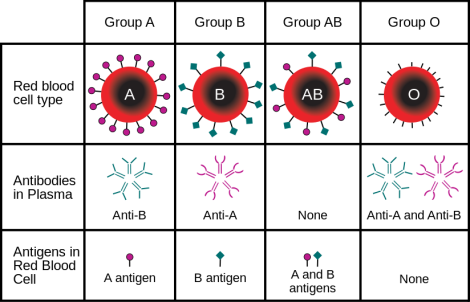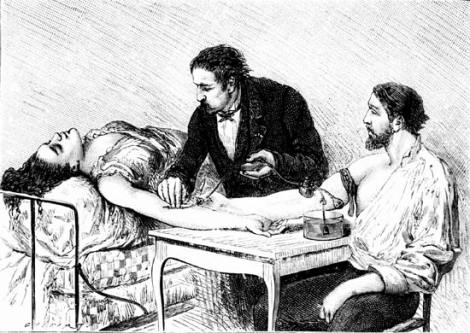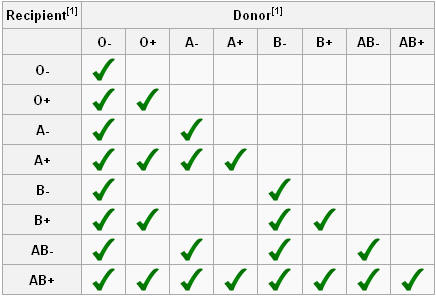Let’s talk about why it’s good to know your blood type. If the grid is down, and you’re down and in need of a blood transfusion, it’s going to make life a whole lot easier and safer for everyone if you could communicate your blood type to your caregivers so they can match donor blood to your blood quickly. Furthermore, if something happens to someone you care about and he or she needs a transfusion, it’s going to make life much easier and safer for everyone if caregivers knew you were part of a walking blood bank[1] of people that could donate in a pinch.
To that end, if you haven’t been typed, here are the safest ways to go about it.
1. Donate blood with the Red Cross. They’ll type it for you and mail you a card with your blood type on it. It costs nothing and you’re being a Good Guy® in the process. Save the card somewhere smart. I lost mine. Duh.
2. Go get a biometric screening and ask them to type your blood. Yeah, that biometric screening with the basic chemistry panel that shows your cholesterol, liver enzymes, kidney enzymes, and the other markers that show you’ve been angrily sitting in front of a computer for months, enjoying nice bourbon, pizza, and getting metabolic syndrome? That one. Get it done and get your blood typed in the process. It costs money. If you have insurance, it might not be too bad. If it’s out of pocket, the lab fees can be a monster, so look at option 1 or option 3.
3. Buy a typing kit online. There’s a company called Eldon that seems to be the big supplier of these things. They claim on their website to be used by blood banks, the US military, and search and rescue (SAR) orgs. I have to believe in our litigious society if their product didn’t work, they’d be sued out of business. Price is pretty decent and may be something you would pack in your expedition medical kit. Use at your own risk!
Now let’s pause for a moment to talk through the ABO blood typing system as well as the Rhesus (Rh) factor. I’m spitballing this because it is a Quick Post, and I have some work to do today, so don’t kill me if I stay pretty general here.
There are four blood groups, A, B, AB, and O. The chart below shows what antigens appear on each red blood cell and the antibodies that appear in the blood serum, which – in way oversimplified form – is the plasma without blood cells (red and white), clotting factors, and fibrinogen. It does contain antigens and antibodies, though[2].

Source: “ABO blood type” by InvictaHOG – Own work. Licensed under Public Domain via Wikimedia Commons – https://commons.wikimedia.org/wiki/File:ABO_blood_type.svg#mediaviewer/File:ABO_blood_type.svg
The very basic way blood groups interact is that any group that has antibodies in the serum against a specific antigen is going to cause an immune response if they are exposed to each other. It’s kind of like gang warfare.
Gang A has its turf, and any Gang B dudes flashing the wrong colors on their turf (those are the antigens) are going to get trouble. Gang A has a big pile of special ammo with those Gang B dudes’ names on it, and they will get jumped. Same story if Gang A trespasses on Gang B’s turf.
As for Gang AB, they are a bunch of smelly hippies, and nobody likes those hippies, so anytime they step outside their place, the lead flies, because their tie dye is often viewed as both Gang A and Gang B colors. Sucks to be them.
Strange thing, though, those lazy AB cats are too stoned to care if anyone walks on their turf and just want to get along. They don’t have antibodies against anyone.
Gang O are a bunch of sneaky bastards (if you’ve seen The Wanderers, these guys would be The Wongs), and you can never tell who’s who and you don’t have any way to tell if you should shoot them or not. So they get left alone if they trespass. But step on their turf and things gets real, right quick.
The resultant immune response presents as what is called agglutination. Below on the right is a slide of what agglutination looks like.
Nasty, yes? Now imagine that going on in your arteries. Not pretty.
OK, Rhesus factor or Rh+ / Rh- indicates the presence of another antigen on the red blood cell (immunogenic type D) and is a suffix to ABO typing. As an example, AB+ is blood type AB that tests positive for the Rh antigen. AB- is blood type AB that tests negative for the Rh antigen. Generally speaking, an Rh+ blood type can take both Rh+ and Rh- donor blood, but an Rh- type can only take Rh- donor blood. Confused yet? Yeah, hematology is fun.
Here’s another chart to simplify:
As you can see, O- is the universal donor because it has no antigens on the cell surface, and AB+ is the universal recipient because it has no antibodies in its serum, even though it does have the Rh+ antigen.
OK, so let’s say the Galactic Empire landed AT-ATs on your city and they slow-walked death and destruction everywhere. After a pitched battle and some outstanding small unit tactics from your Rebel Alliance cell, the invaders have failed and have been destroyed. However, your buddy Biggs is bleeding out from a shrapnel wound from a proton torpedo hit. He’s lost a lot of blood and a field transfusion is the only answer. Unfortunately, none of you guys knows each others’ blood type, so you’ll have to rig up a field test to see if someone is compatible.
Your R2 unit draws samples from everyone, including Biggs. Of course because he’s an R2 unit, he spins his head around to create a centrifuge to extract Biggs’ serum from his blood. He places five white tiles on a table and puts Biggs’ serum on each one. Next he places a few drops of blood from each cell member on each white tile, which he’s labeled with each team member’s name as well as Biggs’ name. All but one of the tiles shows agglutination under your low-power Rebel Alliance portable micro-mediscope. Wouldn’t you know it, but it’s Tequila-Fett that is Biggs’ match. The R2 unit has all the gear ready to treat anaphylaxis and a pyretic reaction[3], then gives Biggs some diphenhydramine and does a field transfusion, saving Biggs’ life.
All kidding aside, blood typing and transfusing blood is very serious business. As I stated earlier, this is a grossly oversimplified view of how it all works. Field transfusing is fraught with peril because you have to remember blood-borne illnesses and pathogens like AIDS, HIV, Hepatitis, Ebola (shout out to our bro, Aesop) and a host of other nasties WILL be transfused into your patient if donors are not thoroughly screened. Furthermore, you can still risk a severe allergic reaction, even if everything looks OK on the surface. Do not take this lightly. It is a desperate procedure for a desperate moment.
A final note. Here is a table courtesy The Red Cross on blood types by population in these United States. Check it out to see how prevalent your blood type is and plan accordingly.
|
|
Caucasians
|
African American
|
Hispanic
|
Asian
|
|
O +
|
37%
|
47%
|
53%
|
39%
|
|
O –
|
8%
|
4%
|
4%
|
1%
|
|
A +
|
33%
|
24%
|
29%
|
27%
|
|
A –
|
7%
|
2%
|
2%
|
0.5%
|
|
B +
|
9%
|
18%
|
9%
|
25%
|
|
B –
|
2%
|
1%
|
1%
|
0.4%
|
|
AB +
|
3%
|
4%
|
2%
|
7%
|
|
AB –
|
1%
|
0.3%
|
0.2%
|
0.1%
|
Homework
Get your blood typed, and if you are going to be around a group of people for extended time in austere conditions, make sure you guys have a way to share that information before there is a critical need for it. Buy some cool guy blood type patches, too.
References
1. Iserson, K.V. (2012). Transfusion. Improvised medicine, Providing care in extreme environments. (pp. 240-246). New York, NY: McGraw Hill Medical
2. Serum(blood). (n.d.). In Wikipedia Online. Retrieved from https://en.wikipedia.org/wiki/Serum_%28blood%29
3. United States Special Operations Command. (2001). Procedures. Special Operations Forces Medical Handbook. (pp. 8-14 – 8-21). Retrieved from https://www.dropbox.com/s/2b4rgh3irny27t5/SOF_Medical_Handbook.pdf?dl=0






Reblogged this on Starvin Larry and commented:
Read, and then follow the advice.
LikeLike
Eldon Cards are not expensive, considering.
Should have a small stack of them in any Grid Down Med kit.
LikeLike
Pingback: Hogwarts: Get Your Blood Typed | Western Rifle Shooters Association·
You can also get kits from the “Eat Right for your Blood Type” folks..books by Peter D’Ammo….quick and easy to do at home. I sell them to my patients. I also advocate the eating plan…easily correct for 90% of people.
LikeLike
Eldon cards are not FDA approved for transfusion typing. They also have a finite shelf life.
Military dog tags are inaccurate up to 10% of the time, we didn’t spend any time looking at them in CSH’s, and absolutely don’t care in a civy ED (how would we know they are actually the patients, and not their relatives?). Same with CDI blood patches.
The SOFMH instructions include typing and cross-matching blood products, for a reason.
LikeLiked by 1 person
Agreed. A formal crossmatch is BY FAR the best method. And I’ve certainly seen reactions in the hospital.
The SOF handbook (at least the older one I have) refers to transfusions in the hospital, and the procedure is identical to that used in any Western hospital. As you know, IvyMike is referring to a “field transfusion”. I agree that this is an inherently dangerous procedure as there is no way of determining if the two patients are actually matched. For the non-medical readers, the ABO, Rh+/- antigens are generally considered the “major” antigens, but there are a host of “minor antigens” such as Duffy, Kell, etc. Despite their minor status, if a patient has had prior transfusions, they develop antibodies to the uncrossmatched minor antigens. Even minor antigens can get you if they gang up on you. Transfusion with non-crossmatched blood can certainly transform “bad” into “lethal”, and there are significant limitations in its use. I’d certainly not do this without a pretty clear-cut, desperation situation as a bridge to definitive care.
LikeLiked by 1 person
One of these things is not like the other. ……
1) you are in a CSH with a full lab and established protocols for a walking blood bank. and you transfuse whole blood.
2) you are in a level one trauma center and started with O neg then gave type specific PRBC from a robust blood bank.
3) you are in a lifeflight helicopter doing an in flight transfusion of PRBC blood picked up after cross match from a community level 3 hospital enroute to a level one trauma center.
4) you are in outer zambia and the villiage chief says if my son, who just took a spear to the chest, dies you Bert and Ernie will also die. Big Bird brought your large trauma aid bag.
In ideal settings you have resources. Modern SF teams train on doner to recipient transfusion in live tissue labs, but rarely use it due to extensive resources available in main theatres of conflict. I have done rough agglutination in the palm of my hand. (The good news is all goats are type G)
Keep in mind this was common practice in WW2 and saved many lives in austere settings.
This type of medicine is only done in austere settings, something most US practitioners have not fully experienced.
Cards if fresh and kept out of the heat can give you a clue where to start, agglutination testing if possible is very helpfull,
start transfusing slow for 15 min if possible, check temp and skin closely. They are no substitute for a not available blood bank but work better than a coin toss.
Improvised centrifuge:
A sock on a string swinging overhead with a test tube in it. Takes a while.
A test tube taped to a bike wheel spinning in the air, works great.
Doc Bowman is right blood markings in the CSH are meaningless. I deployed once with a unit where the clerk made up blood types on ID cards just to get the job done. However if you are on a tight team that works together often in resource poor settings, and you get typed as described above by the red cross, and you provide your paperwork to the team doc, and he then uses that data later……. again better than a coin toss in the wind.
Remember the chief in #4 has not learned how to sue his doctor, so you are the colateral.
Your family and team may need your help. What will you do by yourself with what you have? Thats what we are talking about today.
The other option is watching the life drain out and the eyes fade. Tell yourself you did all you could.
LikeLike
I’d also recommend in getting you blood checked twice and the third time if the results are different. Until I was 18 my Military medical records and dog tags (dependent) were A+; when I gave blood in College with the Red Cross I came back A-, then after enlisting I was still A-. I am just happy that I didn’t need a transfusion, until I finally got the correct blood type.
LikeLike